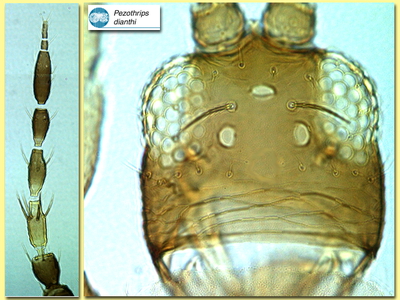Figures
Fig. 1 Antenna and head (dorsal)
Fig. 2 Pronotum
Fig. 3 Fore and hind wing
Fig. 4 Meso- and metathorax
Fig. 5 Sternite V
Fig. 6 Tergite VIII
Species
Pezothrips dianthi Priesner
Biology
This is a minor pest species that has been considered to be largely specific to the flowers of Dianthus species, although it is not known as a pest of these flowers in North America.
Distribution
Central Europe; also recorded from North Africa and some northern States of the USA.
Recognition
Body and legs brown, tarsi and fore tibiae yellowish; antennal segment III yellow, IV brownish yellow; forewings light brown with base pale. Head with transverse lines of sculpture near posterior margin; 3 pairs of ocellar setae present, III longer than distance between two ocelli and arising just outside ocellar triangle. Antennae 8-segmented, III & IV with sense cone forked and slender; III with constricted apical neck; VIII longer than VII. Pronotum with 2 pairs of long posteroangular setae. Metanotum with median setae long and arising at anterior margin. Forewing with 2 setae on distal half of first vein, second vein with complete row of setae. Tergites without ctenidia laterally; VIII with posteromarginal comb of slender regularly paced microtrichia; X fully divided dorsally in mid-line. Sternites with no discal setae, VII median setae arising in front of posterior margin, both lateral pairs displaced laterally. Male similar to female in structure but smaller and paler; tergite IX with median pair of setae short and very stout; sternites with numerous small glandular areas.
Related species
This species used to be placed in the genus Taeniothrips, although it is not closely related to the few species now retained in that genus. It is now placed, together with 8 other species originally from southern Europe, in the genus Pezothrips, although this group remains poorly defined.







